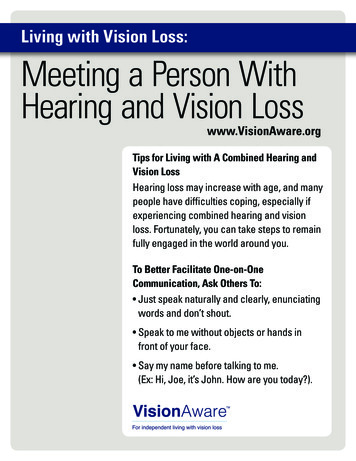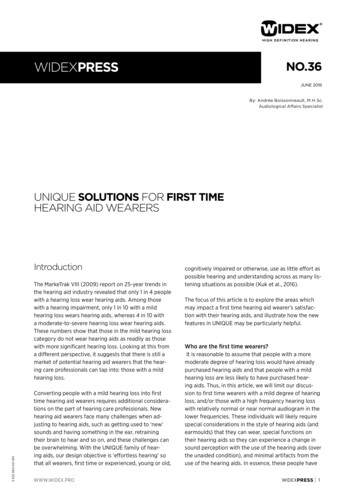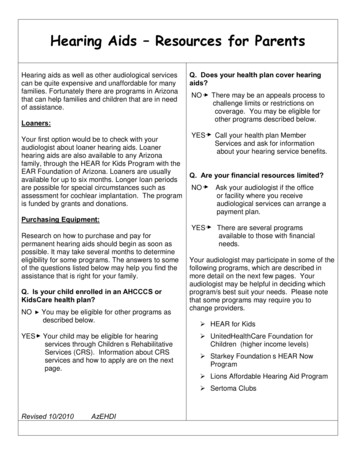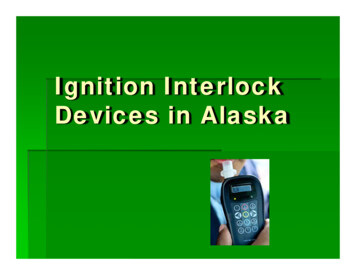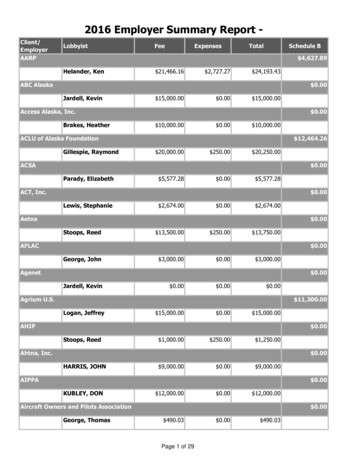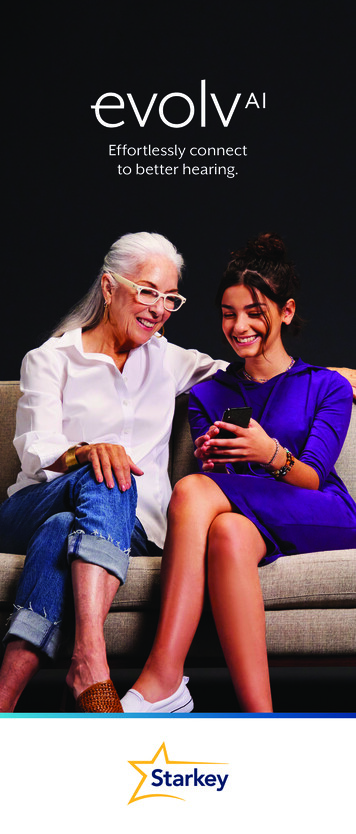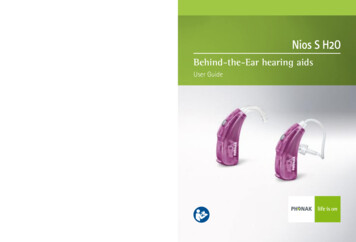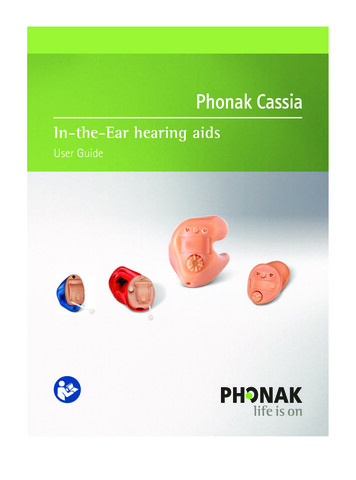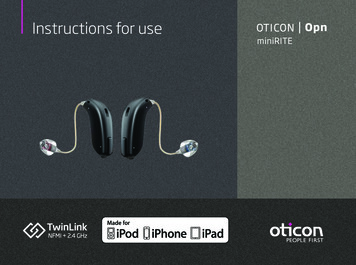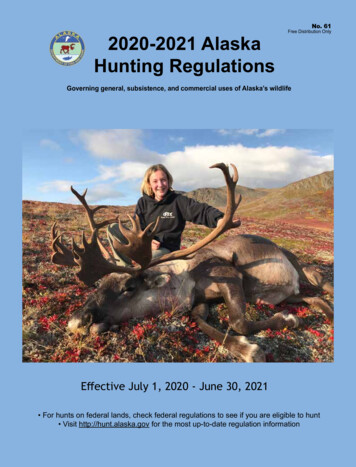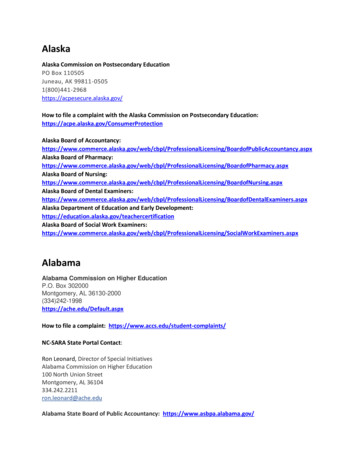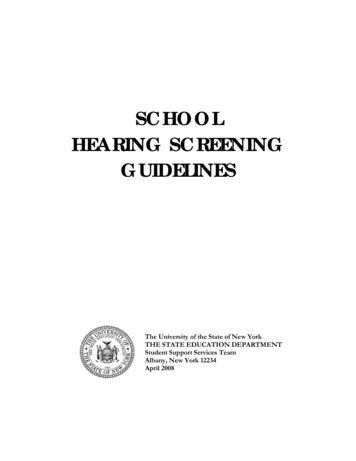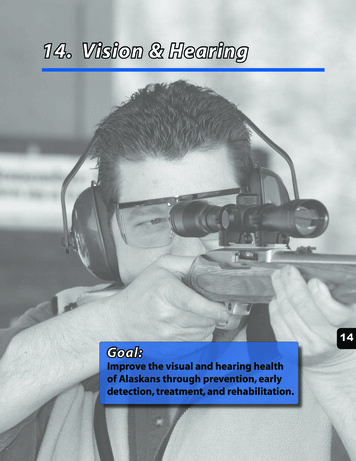
Transcription
14. Vision & Hearing14Goal:Improve the visual and hearing healthof Alaskans through prevention, earlydetection, treatment, and rehabilitation.
14. Vision & HearingHealth Goal for the Year 2010: Improve the vision and hearing of Alaskans throughprevention, early detection, treatment, and rehabilitation.IndicatorAlaska DataSourceU.S.BaselineAlaskaBaselineAlaska TargetYear 2010Vision12Increase the proportion of people over 50 years who havehad an eye exam in the previous three years.Special SurveyIncrease the proportion of preschool children aged 5 yearsand under who receive vision screening.Public HealthNursing; EarlyPeriodic ScreenDiagnosis andTreatment;Division ofMedical Assistance, RPMS3 Reduce eye injuries resulting in hospitalization.4Reduce occupational eye injuries (rate per 10,000 0 injuriesper year(1994-1998)18DOL6.6 (1998)11 (1998)642% (2000)90%Hearing5Increase the proportion of newborns who are screened forhearing loss by age 1 month.Maternal Childand FamilyHealth6Increase the use of protection devices to prevent noise-induced hearing loss.Special lopmentalNHIS - National Health Interview SurveyRPMS - Resource Patient Management SystemDOL - Alaska Department of LaborEHDI - State-based Early Hearing Detection and Intervention Program Network, CDCNHANES -National Health and Nutrition Examination Survey14-2Healthy Alaskans 2010 - Volume I
14. Vision & HearingVision and hearing provide the cues for conductingthe basic activities of daily life. Either or both of thesesenses may be impaired or lost because of heredity,aging, injury, or disease. Many of the causes of visionand hearing loss can be prevented or treated.Blindness and visual impairment from many eye diseases and disorders can be reduced with early detection and treatment. Most eye diseases, however,lack symptoms until vision is lost. Early interventionthrough regular examinations is crucial to maintainadequate vision. Health education programs shouldinclude information on the benefits of vision screening and eye exams.Rehabilitative services are crucial in enabling people with sensory impairments to live independent andproductive lives. Assistive technologies can provideaccess to reading material, computers, telephones,and other components of daily life. Rehabilitation andassistive services are covered in Chapter 25: Disability and Secondary Conditions.There is no consensus on the optimal frequency of eyeexaminations in healthy, asymptomatic adults, or onthe frequency of glaucoma testing on low-risk individuals. The incidence of many eye diseases increaseswith age, and the American Optometric Associationrecommends annual eye examinations for adults 61and older.IntroductionThe Infant Learning Program provides services to visually or hearing-impaired children under age three.Special education services may be available from agethree to 22. Alaska Vocational Rehabilitation servesolder children and adults whose ability to work is impaired.VISIONOverviewVision is an essential part of everyday life for people ofall ages. Vision affects development, learning, communicating, working, health, and quality of life. When lowvision is defined broadly as visual problems that affectthe performance and enjoyment of everyday activities,almost 14 million people in the United States are estimated to have low vision. More than two-thirds of visually impaired adults are over 65 years of age.Leading causes of visual impairment are diabetic retinopathy, cataract, glaucoma, and age-related maculardegeneration (ADM). Myopia, or nearsightedness, is acommon condition in which images of distant objectsare focused in front of, instead of on, the retina. Myopiaoccurs in approximately 25 percent of the United Statespopulation and is frequently diagnosed in school-agedchildren.Issues and Trends in AlaskaThe United States Census Bureau estimates that ofthose Alaskans 16 and older about 10,000 are visually impaired and another 1,300 are severely visuallyimpaired.The Alaska Birth Defects Registry began collectingdata on congenital eye anomalies in 1999. Six infantswith birth defects involving vision were reported inthat year, for a combined rate of 0.6 per 1,000 livebirths.The incidence of diabetes is increasing in Alaska, anddiabetic retinopathy is the leading cause of blindnessamong adults. An estimated 20 to 60 Alaskans losetheir vision annually to diabetes. In a 1999 survey of500 Alaskans with diabetes, 12 percent reported retinopathy and 8 percent had laser surgery for diabeticeye disease.Tight control of blood sugar and early identificationand treatment of retinopathy can preserve vision. Anannual eye exam is essential for diabetics. In 1993,however, only 63 percent of Alaskans with diabetesreported a dilated eye examination within the pastyear. Chapter 23 on Diabetes addresses plans to increase the number of Alaskans with diabetes who receive an annual eye exam.Many infants and young children are at risk for visionproblems because of heredity, prenatal, or perinatal factors. Early identification is important to prevent or reverse visual and developmental problems.Healthy Alaskans 2010 - Volume I14-314
14. Vision & HearingFigure 14-1 Eye injuries are another cause of impaired vision. TheAlaska Trauma Registry reports that 15 people witheye injuries were hospitalized in 1998. Occupationalinjuries to the eye occur at a higher rate in Alaska thanthe United States as a whole (Figure 14-1).Current Strategies and ResourcesThe American Academy of Pediatrics recommendseye examination of infants at all encounters and visionscreening beginning at three years of age. In Alaska,the Early and Periodic Screening, Diagnosis, andTreatment (EDSDT) program requires eye and visionexaminations at each scheduled examination. There isno central database of the results of these screenings.The Head Start Program also provides vision screening for eligible children.Alaska schools require vision screening at entry andprovide periodic screenings. Most schools do not havenurses, and volunteers with limited training often perform screenings. The Department of Education andEarly Development does not collect data on school vision screening or the results of follow-up on studentsidentified with vision impairments.14-4Community photo screening, a simple process to identify eye disease, was offered to Alaskan preschoolersin 1998 and 1999 thorough the Alaska Blind ChildDiscovery Project in collaboration with civic organizations, health corporations, Headstart and PublicHealth Nursing. Volunteers conducted Polaroid photoscreening on 3,930 children between one and fouryears of age and identified 300 children with amblyopia or other significant eye disease. The project foundthat it was feasible to conduct large-scale screeningswith trained volunteers even in remote areas. Routinephoto screening of pre-schoolers, however, has notyet been proposed by any professional organization.HEARINGAn estimated 28 million people in the United Statesare deaf or hard of hearing. Deafness or hearing impairment may be caused by genetic factors, noise,trauma, medications, and viral or bacterial infection.Unrecognized hearing loss in the first three years oflife may impair the development of language. Congenital hearing loss occurs in 2 or 3 children per 1,000live births. Early identification of hearing impairments is crucial in preventing language delay. Hearing aids or cochlear implants may improve hearing.Other children may learn sign as their primary language during the most crucial period for language development.Hearing screening should begin in the newborn nursery. The National Institutes of Health and the American Academy of Pediatrics have recommendeduniversal newborn hearing screening. By 2,000, 32states had legislation mandating newborn hearingscreening.Noise-induced hearing loss is common in the UnitedStates and is the most common occupational disease.Data indicate that people are losing their hearing earlier in life and that men in the 35 to 65 year old agegroup are the most severely affected.Presbycusis, the loss of hearing associated with aging, affects about one third of adults over 65. Only onefourth of the adults who could benefit from a hearingaid actually use one. As the population ages and liveslonger, hearing impairment becomes a more widespread and significant cause of disability. There are nocurrent recommendations for routine hearing screening in asymptomatic adults. Providers are advised toHealthy Alaskans 2010 - Volume I
14. Vision & Hearingask elderly clients about symptoms of hearing lossand test hearing as indicated.Issues and Trends in AlaskaFour hospitals in Alaska now perform routine hearingscreening of newborns. Forty-six percent of the babiesborn in Alaska in 2000 were screened. With approximately 10,000 births annually, 20 to 30 infants wouldbe expected to have congenital hearing impairments.In 1999, the Alaska Infant Learning Program providedaudiology, speech, or language services to 41 childrenunder age four. Ten of those children had significantand progressive hearing loss.Hearing is crucial for language development and success in school. Alaska schools require hearing screening at entry and periodically throughout the child’sschool career. Some schools have professional schoolnurses. Many schools have no school nurses and mustrely on different skill levels of providers who performscreenings. Public Health Nurses also perform hearing screenings during EPSDT screenings. Over 200children a year receive special educational servicesdue to hearing impairment (Figure 14-2).Figure 14-2 Many Alaskans have permanent, irreversible hearingloss caused by noise or trauma. Alaskans have manyoccupations and lifestyles with injurious noise levels.Chainsaws, small aircraft, outboards, snow machines,guns, and all-terrain vehicles are common sources ofhigh-decibel sound. Noise-induced hearing loss canbe the result of a traumatic, sudden level of impulsenoise, such as an explosion, that can leave an individual immediately and permanently deafened, continuing exposure to high levels of sound in the workplaceor in recreational settings, or years of exposure causing subtle, progressive damage. Noise-induced hearing loss is related to noise level, proximity to theharmful sound, duration of exposure, and individualsusceptibility. Many of these causes can be controlledthrough education and prevention.Current Strategies and ResourcesIn April 2000, the Alaska Division of Public Health,Section of Maternal Child and Family Health wasawarded a 4-year grant to develop and implement aUniversal Newborn Hearing Screening Program. Theproject calls for developing and supporting a systemto ensure that newborns are screened for hearing lossprior to discharge from the hospital. Infants who arereferred from screening receive appropriate audiological evaluation and follow-up, and infants with aconfirmed hearing loss receive early intervention andother needed resources.Legislation introduced in March 2001 would mandatenewborn hearing screening in all hospital nurseries.The bill sets a goal of screening 90 percent of Alaskanewborns by January 2003. duce antibiotic use in the treatment of otitis media, asthe widespread use of antibiotics contributes to the development of resistant strains of Streptococcus pneumoniae and other bacterial organisms. Historically, otitis media has been a significant problem in many rural areas of the state. Otitis media oftenoccurs in repeated bouts, causing periods of hearingloss that can affect children during the critical time forlanguage and speech acquisition. It is important to re-Healthy Alaskans 2010 - Volume IPublic education can promote hearing health and behavior to reduce noise-induced hearing loss, which isa fully preventable condition. Public Health Nursinghas high quality, comprehensive guidelines for hearing history, screening, and referral process for all children. Education about the behavioral aspect of noiseinduced hearing loss is standard anticipatory guidanceand could be promoted as standard practice for allchild health providers.Otitis media continues to be an issue, especiallyamong rural Alaska Native children. The Alaska Fed-14-514
14. Vision & Hearingeral Health Care Access Network Telemedicine Project for videootoscopy screening in underserved areas of thestate will help to ensure that children with otitis are treated appropriately. Use of the video-otoscope may alsodecrease the unnecessary use of antibiotics to treat otitis.Data Issues and NeedsPublic Health Nursing records and the RPMS database could potentially provide estimates of the number andproportion of children screened for vision and hearing problems and referred for further evaluation. School districts could track and report the results of school screenings.As the proportion of newborns receiving hearing screening increases, more data will become available on theprevalence of congenital hearing loss.Little information is available on eye examinations in older adults. Special surveys and RPMS records couldprovide some data on the incidence and prevalence of glaucoma, age-related macular degeneration, and cataracts.Special surveys and observational studies could provide baseline data on the use of hearing protection in specific settings, such as snowmachine or chain-saw use.Related Focus AreasA variety of objectives in other Healthy Alaskans chapters are linked to the objectives in Vision and Hearing. Occupational Safety and Health Diabetes DisabilityOccupational eye injuries and noise-induced hearing loss are significant concerns in the workplace and are indicators in the Occupational Safety and Health chapter. Diabetes is linked to Vision and Hearing since peoplewith diabetes often develop diabetic retinopathy. In Diabetes, an important indicator is annual dilated eye examinations to screen for retinopathy. Prevention of blindness and deafness decreases the number of people living with these disabilities, linking to the Disability and Secondary Conditions chapter.EndnotesCenters for Disease Control and Prevention. Diabetes in the United States, 1994.Alaska Department of Health and Social Services, Alaska Division of Public Health, Section of Epidemiology.Alaska Diabetes Control Program: State of Alaska Diabetes Control Plan. November 1999.3Alaska Department of Health and Social Services, Alaska Division of Public Health, Section of CommunityHealth and Emergency Medical Services. Alaska Behavioral Risk Factor Surveillance System, 2000.4American Academy of Pediatrics. Policy statement: Eye examination and vision screening in infants, children,and young adults. July 1996; 98(1):153-157.5Arnold, R.W.; Gionet, E.G.; Jastrzebski, A.I.; Kovtune, T.A.; Machida, C.J.; Armitage, M.D.; and Coon, L.J.The Alaska Blind Child Discovery Project: Rationale, Methods, and Results of 4000 Screenings. Alaska Medicine 2000; 4(3):58-72.6Early Hearing Detection and Intervention Program, Alaska Section of Maternal, Child, and Family Health.May 2000.7Centers for Disease Control and Prevention, National Center for Infectious Diseases, Arctic InvestigationsProgram. www2.cdc.gov/ncidod/aip/Village news/Village news.asp Accessed May 17, 2001.1214-6Healthy Alaskans 2010 - Volume I
14. Vision & HearingReferences and SourcesAlaskaAlaska Optometric Physician AssociationAlaska Early Hearing andIntervention ProgramDHSS: Maternal, Child, & Family HealthSpecial Needs Service UnitSpecial Education Service AgencyNationalOperation Bright StarThe Early Hearing Detection andIntervention ProgramVision Problems in the U.S.National Eye InstituteHealthy Vision 2010www.akoa.org/story.dbm?sid mwww.healthyvision2010.org/14Healthy Alaskans 2010 - Volume I14-7
14. Vision & HearingChapter NotesSAf ALASoETKATe14-8oficoaltmSer vic esD eparntH e alt h a n d SHealthy Alaskans 2010 - Volume I
Division of Medical Assis-tance, RPMS Developmental (NHIS) Developmental 3 Reduce eye injuries resulting in hospitalization. Trauma Registry N/A 20 injuries per year (1994-1998) 18 4 Reduce occupational eye injuries (rate per 10,000 full-time workers). DOL 6.6 (1998) 11 (1998) 6 Hearing 5 Increase the proportion of newborns who are screened for
